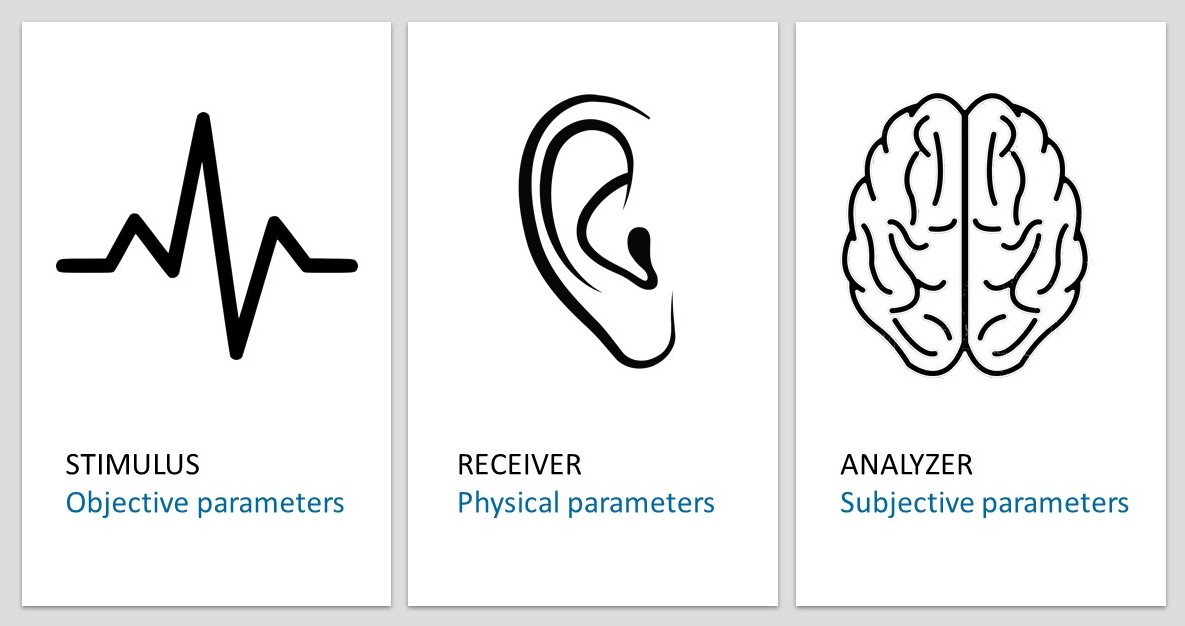Context
Hearing is a cognitive phenomenon : auditive perception can be improved with experience, but it can also diminish with age, hearing fatigue or traumatism. Perception varies from a person to another, but also over the life of an individual . It is therefore essential to take into account the human dimension when analyzing a sound to accurately describe the way it is perceived.

An accurate description of a sound forges links between the measurable acoustic parameters, the ear anatomy and sensitivity but also the way the sound is subjectively perceived by humans.
Definition
Psychoacoustics is an interdisciplinary science focusing on the psychological perception of sound. It establishes relationships between objective physical parameters (sound pressure level, frequency, ear anatomy…) and subjective hearing impressions (pleasantness, pitch, perceived volume…). Different psychoacoustic metrics such as loudness, sharpness, tonality and roughness provide a linear representation of human hearing perception. Each metric measure one specific sound parameter: level for roughness, amount of high-frequency components for sharpness, etc. However human auditory perception is global and takes into account all different parameters according to complex auditory phenomena. It is thus needed to combine the different metrics within a global sound quality estimation to get a good estimation of the human ear perception. It is done with hearing tests following rigorous protocols with a sufficient number of normal-hearing subjects.
Illustration
Vivaldi, Summer presto from the Four Seasons [1]
Car window electric motor [2]
These two sounds are obviously different, but it is not easy to accurately describe how much they differ and why by using the classical acoustic plots and metrics (time history, overall dB level and spectrum). From the time histories below it is only possible to differentiate the time envelopes of the signals. The Vivaldi’s signal wave shows more variations, due to the nuance range and the orchestration. On the opposite, the car window electric motor seems more steady.


Their third-octave spectra look quite similar.

This example highlights that classical metrics are not sufficient to explain why the perception we have of those two sounds significantly differ. There is a real need for human-perception based sound analysis.
e-NVH application
The growing interest in psychoacoustics and noise quality of electrical motors is partly the consequence of the development of Hybrid Electric Vehicles (HEV) and Electrical Vehicles (EV). Indeed, electromagnetically-excited noise in automotive applications may imply several acoustic issues. EOMYS can help to diagnose e-motors noise issues in order to translate a subjective assessment: “I don’t like the sound of this motor” into an objective characterization with psychoacoustic metrics. This objective analysis allows to define an efficient noise reduction process. At design stage, EOMYS can offer both electrical engineering and mechanical noise reduction solutions taking into account psychoacoustics parameters. Indeed, in specific cases, it is more relevant to reduce subjective annoyance (e.g. roughness) rather than decrease the overall noise level . More than noise reduction, EOMYS can help electrical engineers to conduct e-motors design driven by psychoacoustic. That kind of approach brings new possibilities of acoustic signature and comfort (e.g. acceleration feeling), without adding any additional sound source.
See also
- What is masking effect?
- What is acoustic loudness?
- What is acoustic sharpness?
- What is acoustic tonality?
- What is modulation effect, fluctuation strength and roughness?
Sound Sources
[1]https://freemusicarchive.org/music/John_Harrison_with_the_Wichita_State_University_Chamber_Players
[2] https://lasonotheque.org/detail-1505-vitre-electrique-de-voiture-fermeture-2.html
